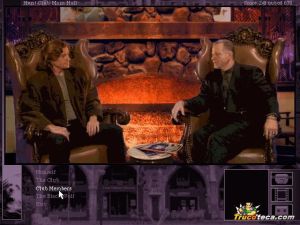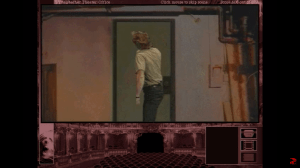Trending
Opinion: How will Project 2025 impact game developers?
The Heritage Foundation's manifesto for the possible next administration could do great harm to many, including large portions of the game development community.

Featured Blog | This community-written post highlights the best of what the game industry has to offer. Read more like it on the Game Developer Blogs or learn how to Submit Your Own Blog Post
Following the critical and commercial success of Gabriel Knight: Sins of the Fathers, Jane Jensen pens a sequel that sees her “shadow hunter” chase werewolves and tap into his carnal side, all under the bright lights of Hollywood.

The following excerpt comes from Once Upon a Point and Click, a collection of retrospectives on the making of Sierra's King's Quest and Gabriel Knight adventure games. Once Upon a Point and Click is currently available from Story Bundle in a pay-what-you-want collection of books centered on game development and culture.
Deliciously Carnal
 Upon its release in mid-December of 1993, Gabriel Knight: Sins of the Fathers marked the dawn of a new type of adventure game. The characters were layered and realistic, and the narrative was multifaceted—dark and haunting, yet humorous at the right moments, and driven by a blend of history and mythology that made for a compulsively playable game. Gabriel Knight was an experience like none before it. Sierra co-founders Ken and Roberta Williams agreed, and gave Jane Jensen their blessing to direct a sequel. Jensen knew precisely the tale to tell.
Upon its release in mid-December of 1993, Gabriel Knight: Sins of the Fathers marked the dawn of a new type of adventure game. The characters were layered and realistic, and the narrative was multifaceted—dark and haunting, yet humorous at the right moments, and driven by a blend of history and mythology that made for a compulsively playable game. Gabriel Knight was an experience like none before it. Sierra co-founders Ken and Roberta Williams agreed, and gave Jane Jensen their blessing to direct a sequel. Jensen knew precisely the tale to tell.
By the end of Sins of the Fathers, Gabriel had relocated from New Orleans to his family castle, Schloss Ritter, in the fictional town of Rittersburg, Germany, and begrudgingly accepted his role as the Schattenjäger, German for “shadow hunter.” The character’s breakout novel, The Voodoo Murders, has skyrocketed to the top of the bestseller list, leaving him wealthy enough to bunker down in the family library and write his next thriller.
Since Gabriel had survived a crucible and achieved material success, Jensen decided the time had come to test his strength of character. She dug up her original idea of Gabriel investigating a series of murders that locals believed to be the work of a werewolf. Casting a lycanthrope as her antagonist achieved several goals. Critics and players had downed her cocktail of historical and supernatural elements thirstily, so it made sense to concoct a second brew with the same flavor.
And the werewolf, a man unable to stop himself from transforming into a bloodthirsty beast at the full moon, made for deliciously carnal symbolism.
“Thematically, at the end of the first game, Gabriel made this decision that he was going to take on the mantle of Schattenjäger,” Jensen explained. “I wouldn’t say he was a sex addict, but he was a womanizer. I wanted him to have to deal with some of those baser aspects of his personality. Werewolves were just perfect for that. The symbolism for the werewolf is letting out that primal instinct, that sexual instinct. So it worked.”
Jensen titled her sequel The Beast Within: A Gabriel Knight Mystery and wrote her script. At the opening, Gabriel battles a foe stronger than werewolves and voodoo priestesses combined: writer’s block. His progress on his next novel is interrupted when a line of villagers carrying flashlights come to the castle in the dead of night to seek an audience with theSchattenjäger. Quipping that they should be carrying torches, Gabriel listens as the villagers tell the grim tale of a little girl slain in the woods by a wolf with human eyes. The murder took place in Munich, a rural area several hours from Schloss Ritter.
Given the choice between the jaws of a werewolf or the dreaded blank page, Gabriel heads to Munich. He follows the werewolf’s trail to a prestigious hunting club led by Fredrich von Glower, a charismatic baron who founded the institution on two philosophies. First and foremost was hedonism, a belief that encourages followers to maximize personal pleasure. The second was primitivism, a back-to-basics way of living dependent on instinct alone.
Back in New Orleans, Grace receives a letter from Gabriel explaining that he has started a new case, and that his assistant and housekeeper, Gerde, will be handling any research that comes up. Convincing herself that she is more perturbed at being left out of the action than by Gabriel spending time with another woman, Grace hops a flight to Rittersburg plumbs theSchattenjäger library. She unearths dusty tomes that mention a mysterious figure known as the Black Wolf, who became a close confidant of King Ludwig II of Bavaria. While Gabriel follows leads gleaned through his membership with the hunting club, Grace becomes entranced by the tragic tale of Ludwig II. So did Jane Jensen.
Bright Lights
Jensen’s final script weighed in at 600 pages. Once she finalized it, she and her producer, Sabina Duvall, began searching for actors. “When we first started out, we tried to cast some local people—basically cutting corners in a way that is pretty evident,” she admitted, laughing. “But after we got going, we said, ‘Screw it,’ and started casting people from L.A. So I think some of the early stuff we shot was cheesy, but I’m very proud of the game.” For the role of Grace, Jensen and her team selected Joanne Takahashi, an actress who had played a few bit parts on TV shows.
While auditions continued, Jensen and Duvall extended an offer to Will Binder, a Hollywood director who got his start working on the production team of Scent of a Woman starring Al Pacino, to helm the project. “I was offered the job to direct by Jane [Jensen] and our producer, Sabina Duvall,” Binder recalled. “Dave Plaskett, the production manager, and I hired Gil Neuman as the first assistant director, and we got to work. At that point, we were way behind schedule so we rushed to cast and complete pre-production and then started shooting.”
Binder’s first order of business was to relocate to Oakhurst and break down Jensen’s 600-page doorstop of a script, a process that involved listing the locations, characters, and props required in every scene. Next, Binder traveled around with Plaskett and Neumann to scout principle locations. The script called for locations across Munich and several of Ludwig II’s famous castles, as well as the fictional settings of Rittersburg and Gabriel’s castle. They decided on Bass Lake for the scene where Ludwig was found drowned; a wooded area for the site of the first werewolf killing that kicked off Gabriel’s investigation; and a hillside for a dream sequence in which Grace glides across a winter wonderland as a passenger in Ludwig’s sleigh. The rest of the scenes, roughly 90 percent of the script, would be conjured from movie magic that Binder and his crew needed ample time to invoke. Unfortunately, time was one resource they did not have.
Binder recalled the challenge of shooting a project so epic in scope. “An average feature film is 120 pages of script. The script for [The Beast Within] was roughly 600 pages. So, in essence, it was the equivalent of five feature films. We were effectively attempting to shoot five feature films in the same amount of time it takes to shoot one film. Add into that the fact that a good percentage of the action took place in [flashbacks], which added the additional complexity of shooting a period piece.”
Binder also juggled casting duties. He and his production team collaborated with Montgomery Parada Casting, a firm based out of Los Angeles. Binder and casting director Dan Parada sat in on every audition to help direct actors. When the time came to cast Gabriel, Binder only needed one audition to find his man: Dean Erickson, a Wall Street businessman who dreamed of breaking into film. Tall and ruggedly handsome with a charming smile and long, dirty-blonde hair, Erickson was the spitting image of Gabriel’s pixelated persona.
The aspiring actor flipped through the script and took an instant liking to Jensen’s shadow hunter. “He was written as a complex character. He was funny, but wracked by doubts and guilt. He had a cool facade, but there were plenty of emotional cross-currents beneath his cool. He was a hero, but a reluctant one.”
 Erickson got Binder’s stamp of approval. Next, he needed Jensen’s. She received tapes of Erickson but was not convinced of his suitability for the role. Binder arranged a meet-and-greet to put her doubts to rest. Jensen admitted that she “wasn’t that impressed with [Erickson] on video, but when I met him in person, I thought he really looked like Gabriel. He just looked like this character. Honestly, I wasn’t crazy about his voice, but we auditioned him on-site.”
Erickson got Binder’s stamp of approval. Next, he needed Jensen’s. She received tapes of Erickson but was not convinced of his suitability for the role. Binder arranged a meet-and-greet to put her doubts to rest. Jensen admitted that she “wasn’t that impressed with [Erickson] on video, but when I met him in person, I thought he really looked like Gabriel. He just looked like this character. Honestly, I wasn’t crazy about his voice, but we auditioned him on-site.”
To test Erickson’s mettle, Jensen asked him to read a scene from the final chapter. The scene takes place at an opera house, where Grace has asked a friend to conduct Wagner’s lost opera in an attempt to expose Baron von Zell, the Black Wolf. But there’s a problem. During a late-night chase through the woods, Gabriel was bitten by another werewolf. In the scene Erickson was asked to read, Grace has locked Gabriel in a storeroom for his own safety—and for hers. Feverish and caged, Gabriel flies into a rage, screaming and cursing and battering at the door.
“I do remember that scene, that reading, and the look in Jane’s eyes that told me I had the part,” Erickson said. “I think I scared her a bit with my intensity during the reading, which was what she needed to see. I probably seemed like a nice, easy-going guy, so she had to make sure I had the fire to play Gabriel. Honestly, I had more than enough personal fire and anger to tap into for Gabriel Knight. As I’ve aged, I’m happy to say I have less so now.”
**
The following excerpt comes from Once Upon a Point and Click, a collection of retrospectives on the making of Sierra's King's Quest and Gabriel Knight adventure games. Once Upon a Point and Click is currently available from Story Bundle in a pay-what-you-want collection of books centered on game development and culture.
Read more about:
Featured BlogsYou May Also Like